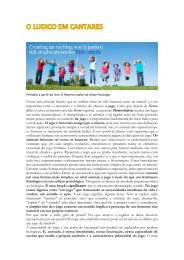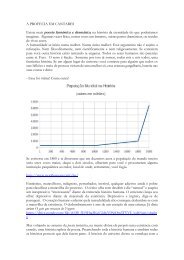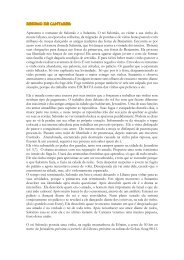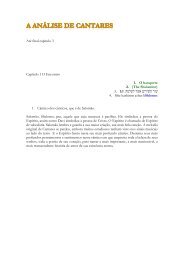Motherhood in Childhood
Create successful ePaper yourself
Turn your PDF publications into a flip-book with our unique Google optimized e-Paper software.
esponsibilities of breadw<strong>in</strong>ner and head of the<br />
household are <strong>in</strong>culcated <strong>in</strong>to boys and men; fulfill<strong>in</strong>g<br />
these behaviours and roles are dom<strong>in</strong>ant<br />
ways to affirm one’s manhood.<br />
Gender norms as a rule establish and re<strong>in</strong>force<br />
women’s subord<strong>in</strong>ation to men and drive<br />
poor sexual and reproductive health outcomes<br />
for both men and women. Women are often<br />
prevented from learn<strong>in</strong>g about their rights and<br />
from obta<strong>in</strong><strong>in</strong>g the resources that could help<br />
them plan their lives and families, susta<strong>in</strong> their<br />
advancement <strong>in</strong> school, and support their participation<br />
<strong>in</strong> the formal economy (Greene and<br />
Levack, 2010). Men are often not offered most<br />
sources of sexual and reproductive health <strong>in</strong>formation<br />
and services and may develop the sense<br />
that plann<strong>in</strong>g families is not their doma<strong>in</strong>, but<br />
rather is women’s responsibility.<br />
In the context of sexual and reproductive<br />
health and reproductive rights, there is grow<strong>in</strong>g<br />
recognition among the <strong>in</strong>ternational community<br />
that address<strong>in</strong>g gender <strong>in</strong>equities <strong>in</strong> health,<br />
promot<strong>in</strong>g sexual and reproductive health and<br />
reproductive rights, and prevent<strong>in</strong>g HIV and<br />
gender-based violence at all levels <strong>in</strong> society<br />
is not possible without efforts to directly<br />
engage men and boys as partners <strong>in</strong> these<br />
processes (International Planned Parenthood<br />
Federation, 2010).<br />
EXCERPTS FROM THE ICPD PROGRAMME OF<br />
ACTION ON GENDER EQUALITY<br />
The objectives are to achieve equality and equity based on harmonious<br />
partnership between men and women and enable women to realize their<br />
full potential; to ensure the enhancement of women’s contributions to<br />
susta<strong>in</strong>able development through their full <strong>in</strong>volvement <strong>in</strong> policy- and<br />
decision-mak<strong>in</strong>g processes at all stages…; to ensure that all women, as<br />
well as men, are provided with the education necessary for them to meet<br />
their basic human needs and to exercise their human rights.<br />
Countries should act to empower women and should take steps to<br />
elim<strong>in</strong>ate <strong>in</strong>equalities between men and women as soon as possible<br />
by establish<strong>in</strong>g mechanisms for women’s equal participation and equitable<br />
representation at all levels of the political process and public life;<br />
promot<strong>in</strong>g the fulfilment of women’s potential through education, skill<br />
development and employment, giv<strong>in</strong>g paramount importance to the<br />
elim<strong>in</strong>ation of poverty, illiteracy and ill health among women; elim<strong>in</strong>at<strong>in</strong>g<br />
all practices that discrim<strong>in</strong>ate aga<strong>in</strong>st women; assist<strong>in</strong>g women to establish<br />
and realize their rights, <strong>in</strong>clud<strong>in</strong>g those that relate to reproductive and<br />
sexual health… (Programme of Action, paragraphs 4.1–4.4)<br />
especially whether the mother and father married<br />
as children or whether the mother became<br />
pregnant as an adolescent. Other family-level<br />
determ<strong>in</strong>ants <strong>in</strong>clude the education level of<br />
adults and their expectations for their children,<br />
the level of communication with<strong>in</strong> the household,<br />
the <strong>in</strong>tensity of cultural and religious<br />
values, and the views of family decision makers<br />
on gender roles and child marriage.<br />
Family-level determ<strong>in</strong>ants<br />
Unless a girl lives <strong>in</strong> a child-headed household<br />
or is homeless, she is go<strong>in</strong>g to be <strong>in</strong>fluenced by<br />
her family or guardian. Family-level determ<strong>in</strong>ants<br />
<strong>in</strong>clude the stability and cohesiveness of<br />
the family; the degree to which there is conflict<br />
or violence <strong>in</strong> the home; the extent of household<br />
poverty or wealth; the presence of role<br />
models; and the reproductive history of parents,<br />
Child marriage<br />
The prevalence of child marriage depends <strong>in</strong> part<br />
on national policies and laws and their enforcement,<br />
on community-level norms and on the<br />
extent of poverty <strong>in</strong> a country, but it is at the<br />
level of the family where decisions are made<br />
about forc<strong>in</strong>g a child <strong>in</strong>to a marriage or union.<br />
By def<strong>in</strong>ition, child marriage occurs when at<br />
least one of the partners is under age 18. Every<br />
THE STATE OF WORLD POPULATION 2013<br />
47

















